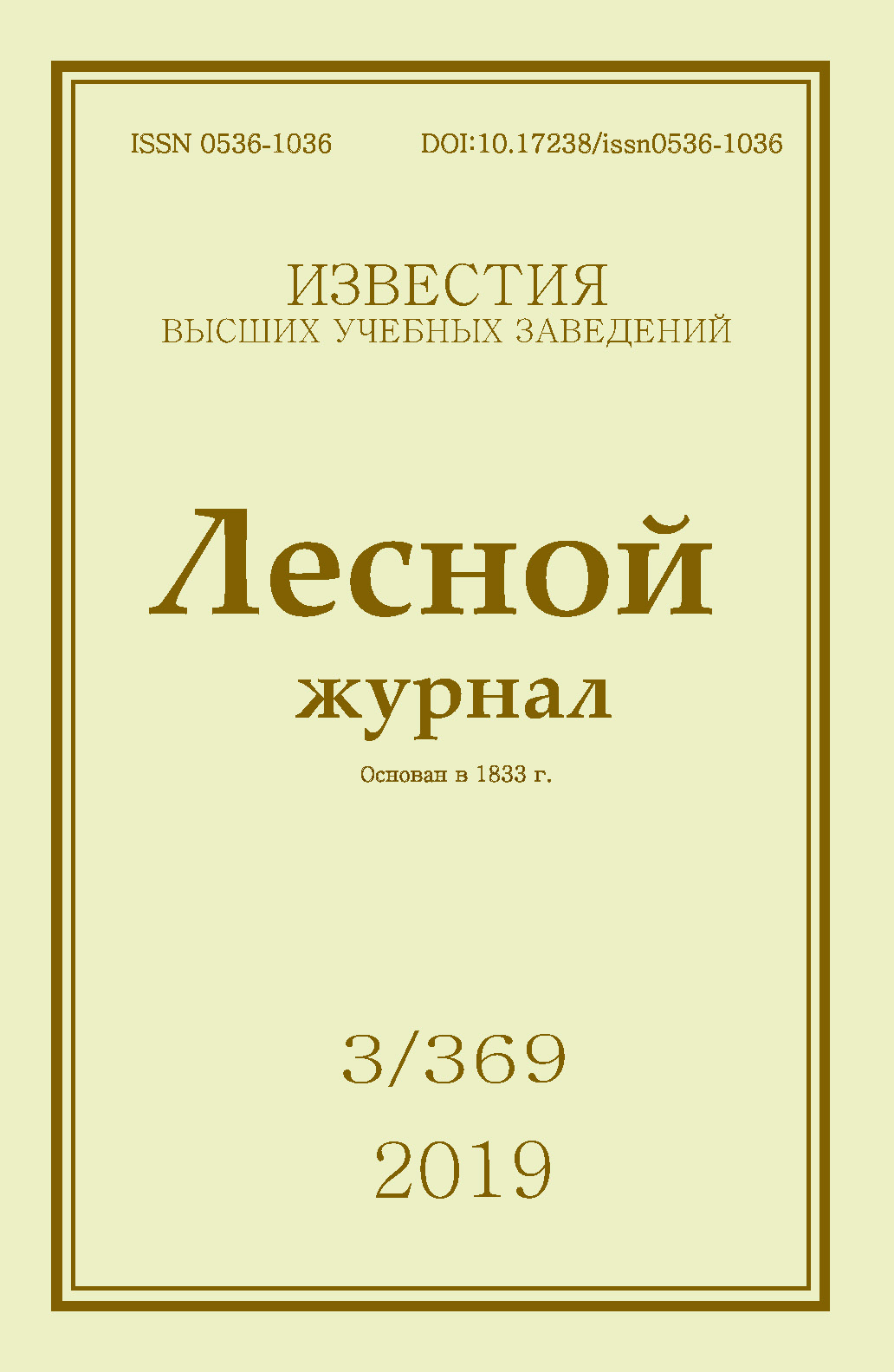Provision with Undergrowth of Mature and Overripe Dark Coniferous Stands in Perm Krai
DOI:
https://doi.org/10.17238/issn0536-1036.2019.3.32Keywords:
Middle Ural taiga forest region, dark coniferous stands, preliminary generation undergrowth, provisionAbstract
Provision with preliminary generation undergrowth of mature and overripe dark coniferous stands of the Middle Ural taiga forest region was analyzed based on the forest management materials’ data of Krasnovisherskoye forestry (Perm krai). It has been found that dark coniferous stands are represented by spruce, fir, and cedar forests; which occupy 55.3 % of area covered with forest vegetation and 83.7 % of area covered with coniferous stands. Herewith, spruce forests occupy 98.7 % of the total area of dark coniferous stands, fir forests – 1.2 %, and cedar forests – 0.1 %. There are stands of the 5th and elder bonitet classes (65.4 %), 3rd and 4th classes (87.1 %) with the stand density of 0.5–0.7 (67.9 % from the total area) among dark coniferous stands. Spruce stands usually belong to the following types of forest sites (forest growth conditions): C3 (66.2 %), B2 (12.5 %) and B4 (9.7 %). Under the canopy 90.8 % of mature and overripe dark coniferous stands’ area is occupied by coniferous un-dergrowth, while its density exceeds 2.0 thousand pcs/ha on 12.0 % of the area. The maximum provision with undergrowth in the C3 and B4 forest growing conditions is characterized by mature and overripe dark coniferous stands with the relative density of 0.6, and in the A4, B2, B5 and C4 forest growing conditions – 0.5. The latter should be considered in selective logging and methods of reforestation schedule.
For citation: Vedernikov E.A., Zalesov S.V., Zalesova E.S., Маgаsumovа А.G., Tolkach O.V. Provision with Undergrowth of Mature and Overripe Dark Coniferous Stands in Perm Krai. Lesnoy Zhurnal [Forestry Journal], 2019, no. 3, pp. 32–42. DOI: 10.17238/issn0536-1036.2019.3.32
Downloads
References
Дебков Н.М. Лесоводственная оценка природного потенциала формирования целевых насаждений из подроста в южной тайге Западной Сибири: автореф. дис. … канд. с.-х. наук. М., 2013. 21 с.
Луганский Н.А., Залесов С.В., Луганский В.Н. Лесоведение: учеб. пособие. Екатеринбург: Урал. гос. лесотехн. ун-т, 2010. 432 с.
Оплетаев А.С., Чермных А.И., Киршбаум А.Р. Обеспеченность подростом предварительной генерации перестойных насаждений Челябинской области // Успехи современного естествознания. 2017. № 7. С. 42–46.
Приказ Минприроды России от 29.06.2016 № 375 «Об утверждении Правил лесовосстановления»: зарегистрировано в Минюсте России 15.11.2016 № 44342. Режим доступа: http://www.consultant.ru/document/cons_doc_LAW_207285/ (дата обращения: 20.13.18).
Фомин В.В., Залесов С.В., Магасумова А.Г. Методики оценки густоты подроста и древостоев при зарастании сельскохозяйственных земель древесной растительностью с использованием космических снимков высокого пространственного разрешения // Аграр. вестн. Урала. 2015. № 1(131). С. 25–29.
Цветков В.Ф. Лесной биогеоценоз. Архангельск, 2004. 268 с.
Цветков В.Ф. Лесовозобновление: природа, закономерности, оценка, прогноз. Архангельск: АГТУ, 2008. 212 с.
Чмыр А.Ф. Плавная смена поколений еловых лесов бореальной зоны России. СПб.: СПбНИИЛХ, 2001. 127 с.
Aguilar-Amuchastegui N., Henebry G.M. Assessing Sustainability Indicators for Tropical Forests: Spatio-Temporal Heterogeneity, Logging Intensity, and Dung Beetle Communities // Forest Ecology and Management. 2007. Vol. 253, iss. 1–3. Pp. 56–67. DOI: 10.1016/j.foreco.2007.07.004
Allen C.D., Macalady A.K., Chenchouni H., Bacheletd D., McDowell N., Vennetier M., Kitzberger T., Rigling A., Breshears D.D., Hogg E.H., Gonzalez P., Fensham R., Zhang Zh., Castro J., Demidova N., Lim J.-H., Allard G., Running S.W., Semerci A., Cobb N. A Global Overview of Drought and HeatInduced Tree Mortality Reveals Emerging Climate Change Risks for Forests // Forest Ecology and Management. 2010. Vol. 259, iss. 4. Pp. 660–684. DOI: 10.1016/j.foreco.2009.09.001
Fomin V.V., Zalesov S.V., Popov A.S., Mikhailovich A.P. Historical Avenues of Research in Russian Forest Typology: Ecological, Phytocoenotic, Genetic, and Dynamic Classifications // Canadian Journal of Forest Research. 2017. Vol. 47, no. 7. Pp. 849–860. DOI: 10.1139/cjfr-2017-0011
Gamfeldt L., Snäll T., Bagchi R., Jonsson M., Gustafsson L., Kjellander P., Ruiz-Jaen M.C., Fröberg M., Stendahl J., Philipson Ch.D., Mikusiński G., Andersson E., Westerlund B., Andrén H., Moberg F., Moen J., Bengtsson J. Higher Levels of Multiple Ecosystem Services Are Found in Forests with More Tree Species // Nature Communications. 2013. Vol. 4, article no. 1340. DOI: 10.1038/ncomms2328
Jactel H., Nicoll B.C., Branco M., Gonzalez-Olabarria J.R., Grodzki W., Långström B., Moreira F., Netherer S., Orazio Ch., Piou D., Santos H., SchelhaasM.J., Tojic K., Vodde F. The Influences of Forest Stand Management on Biotic and Abiotic Risks of Damage // Annals of Forest Science. 2009. Vol. 66, iss. , article no. 701. DOI: 10.1051/forest/2009054
Martin P.J., Browne-Clayton S., Taylor G. A Results-Based System for Regulating Reforestation Obligations: Some Developments in 2003 // The Forestry Chronicle. 2004. Vol. 80, no. 2. Pp. 201–208. DOI: 10.5558/tfc80201-2
Millar C.I., Stephenson N.L. Temperate Forest Health in an Era of Emerging Mega-disturbance // Science. 2015. Vol. 349, iss. 6250. Pp. 823–826. DOI: 10.1126/science.aaa9933
Verheyen K., Vanhellemont M., Auge H., Baeten L., Baraloto Ch., Barsoum N., Bilodeau-Gauthier S., Bruelheide H., Castagneyrol B., Godbold D., Haase J., Hector A., Jactel H., Koricheva J., Loreau M., Mereu S., Messier Ch., Muys B., Nolet Ph., Paquette A., Parker J., Perring M., Ponette Q., Potvin C., Reich P., Smith A., Weih M., Scherer-Lorenzen M. Contributions of Global Network of Tree Diversity Experiments to Sustainable Forest Plantations // Ambio. 2016. Vol. 45, iss. 1. Pp. 29–41. DOI: 10.1007/s13280-015-0685-1







